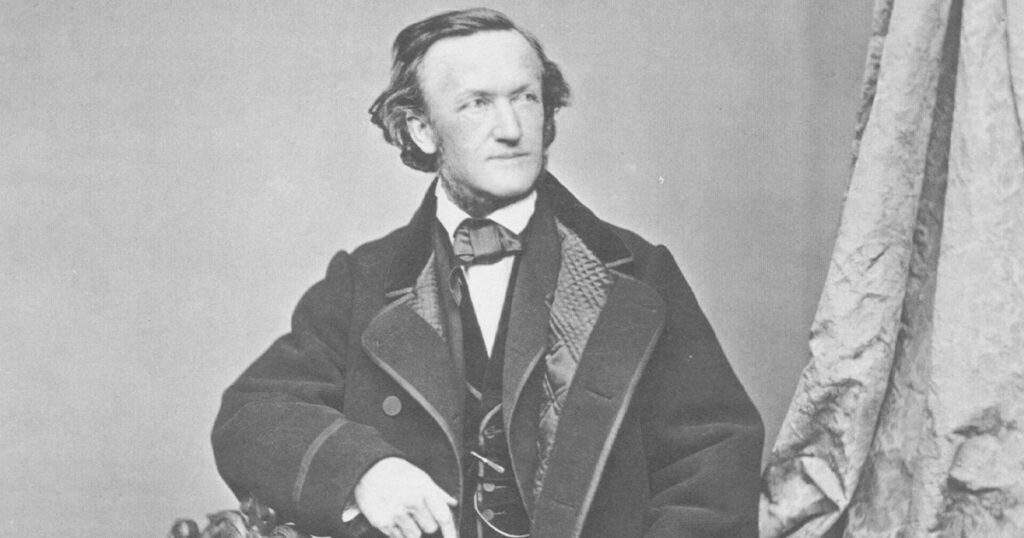
Wagnerism: Art and Politics in the Shadow of Music by Alex Ross; Farrar, Straus and Giroux, 784 pp., $40
Musical genius and bombastic bigot, Richard Wagner (1813–1883) is a cultural Rorschach test. Whereas Thomas Mann saw in him “the greatest talent in the entire history of art,” Friedrich Nietzsche, once a fawning disciple and family intimate, asked: “Is Wagner a human being at all? Is he not rather a disease? He contaminates everything he touches. He has made music sick.” Leonard Bernstein addressed the spirit of the German composer with exquisite ambivalence: “Richard Wagner, I hate you; but I hate you on my knees.”
When the Ring cycle—Das Rheingold, Die Walküre, Siegfried, and Götterdämmerung—inaugurated the Bayreuth Festspielhaus in 1876, it was a testament to Wagner’s grandiosity and a challenge to audience endurance. Staged on four successive nights for more than 14 hours, the operatic marathon anticipated the binge-watching of Game of Thrones except without snacks or bathroom breaks. It was a Gesamtkunstwerk—a total fusion of the arts—that made its expanded orchestra, though newly positioned in a pit, as important as the singers. Wagner introduced such novelties as a contrabass trombone, a bass trumpet, and a Wagner tuba, as well as audience seats that pointed toward the histrionic drama unfolding on stage rather than toward one another. As Wagner wrote in an 1861 letter, “The exclamation point is basically the only punctuation mark for me!” And indeed, his life and work have never ceased to inspire both adulation and antipathy.
Alex Ross’s massive new book is worthy of its subject, which is Wagnerism, and only indirectly Wagner himself. The influence of the German composer has been so far-reaching that it has created a state of mind, even an ideology—or rather, a set of conflicting ideologies. Bach, Mozart, and Beethoven have attracted more devotees, but it is not meaningful to talk in the same way about isms that followed in their wake. Because of what he calls “Wagner’s near-infinite malleability,” Ross, the classical music critic of The New Yorker, finds the Wagnerian imprint almost everywhere—in Pre-Raphaelite painters, Black intellectuals, animated cartoons, crackpot mystics, modernist poets, headstrong architects, fascist politicians, Zionist leaders, more than 1,000 films, and much else. His omnivorous research leads him to unpublished novels by Katherine Mansfield and Jean-Paul Sartre and forgotten poems by Robert de Montesquiou and Oskar Panizza.
Ross likewise makes a convincing—and astonishing—case for Wagner’s presence in the modern literary canon. He credits the composer for stream of consciousness, leitmotifs, and the multivolume novels of Ford Madox Ford, Thomas Mann, Marcel Proust, and Romain Rolland. He demonstrates how crucial Wagner was to Willa Cather, Joseph Con- rad, and D. H. Lawrence and notes that T. S. Eliot lifted five of the first 42 lines of The Waste Land from Tristan und Isolde, and that James Joyce’s Finnegans Wake alludes to that opera 242 times. “Wagner,” contends Ross, “remains the unavoidable beast at the heart of the modern labyrinth.”
“This is a book about a musician’s influence on non-musicians,” Ross writes. So although he does provide analysis, in passing, of each of Wagner’s operas, he omits discussion of Anton Bruckner, Edward Elgar, Gustav Holst, Gustav Mahler, and other musicians who composed in awe of Wagner, as well as of John Cage, Philip Glass, Arvo Pärt, and even P. D. Q. Bach, who rejected Wagnerian sententiousness and chutzpah. But reactions against Wagner are often reactions against other reactions as much as direct responses to the music. This is especially the case in the troubled relationship between Wagnerism and Nazism, the way the composer, who died 50 years before Adolf Hitler took power, became “the chief cultural ornament of the most destructive political regime in history.” The process was brokered by Winifred Wagner, the daughter-in-law who took control of Bayreuth and turned it into a shrine to both Wagnerism and Nazism. It is what led Woody Allen, in Manhattan Murder Mystery, to quip: “I can’t listen to that much Wagner, ya know? I start to get the urge to conquer Poland.”
Ross examines the virulent anti-Semitism that endeared Wagner to Aryan supremacists. In his deranged 1850 essay “Jewishness in Music,” Wagner insisted that, lacking any culture of their own, Jews polluted Europe’s. In a letter to his patron, Ludwig II, he anticipated the Judeophobia in Mein Kampf, Kristallnacht, and the Final Solution: “I consider the Jewish race the born enemy of pure humanity and all that is noble in man.” Yet he entrusted Hermann Levi to conduct the premiere of Parsifal. And many Jews, including Theodor Herzl, Arthur Schnitzler, and Boris Thomashefsky, were Wagnerites. The Jewish philosopher Otto Weininger called Wagner “the greatest man since Christ’s time.” Yet despite the advocacy of Daniel Barenboim, performing Wagner remains taboo in Israel.
Beyond his hatred of Jews, Wagner became the patron saint of the infernal Third Reich because of his immersion in Germanic myths and fascination with raw power. However, as Ross points out, Nazi leaders were hard put to reconcile their image of a jack-booted ultranationalist with Wagner’s pacifist and cosmopolitan sympathies. Admired by militarists and bigots, Wagner was also embraced by those who respected the value he placed on Mitleid (compassion).
Ultimately, Wagnerism is a heterogeneous spread that, unlike ghee, is never clarified. In it, writes Ross, “we see both the highest and lowest impulses of humanity entangled.” Drawn to the highest but slighting War and Peace, Beethoven’s Ninth, and the Statue of Liberty, he calls the Ring “the most monumental artwork of the nineteenth century.” About his own monumental work of passionate scholarship, Ross states: “Writing this book has been the great education of my life.” It has much to offer other lives as well.

